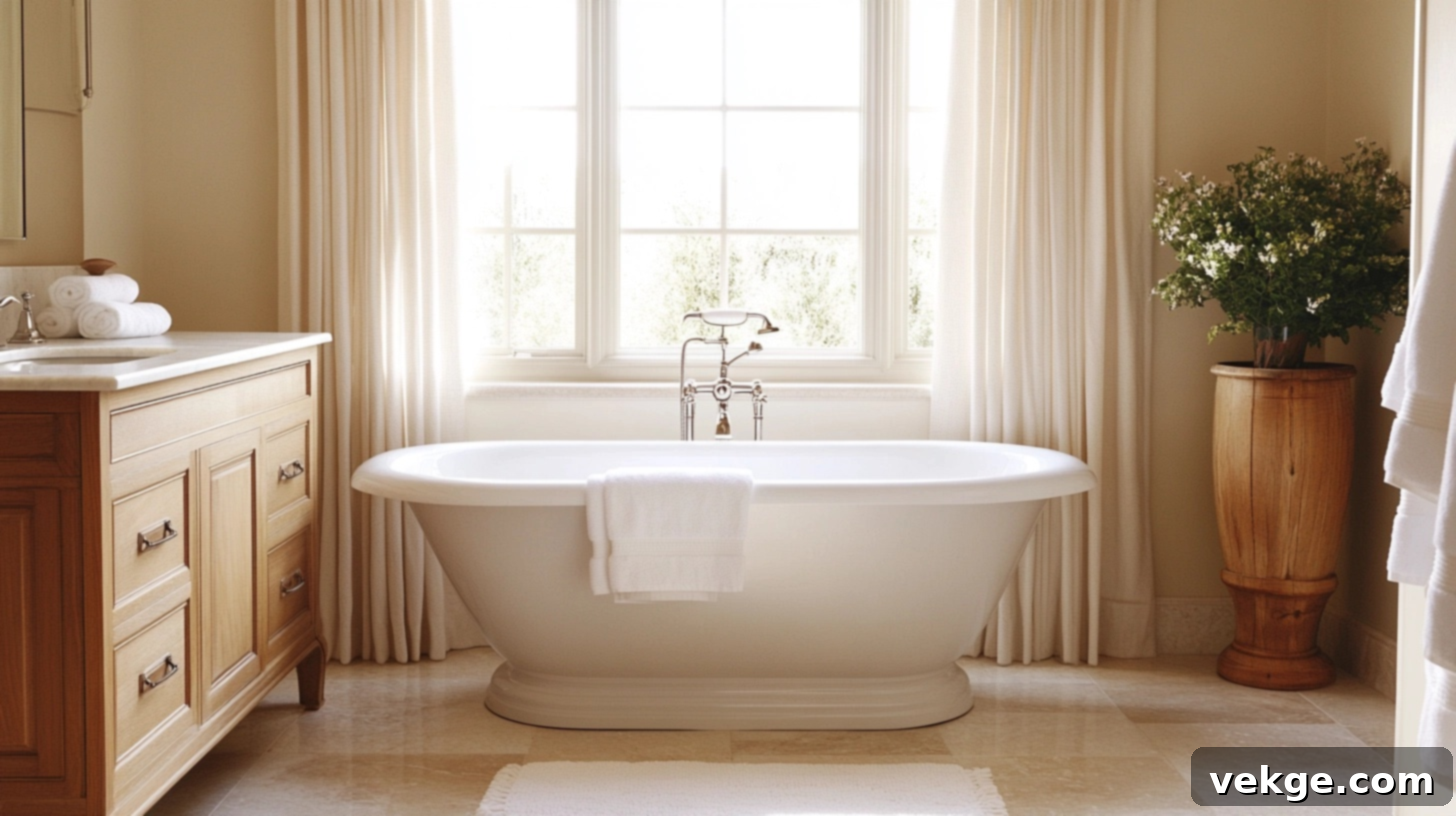Mastering Transitional Bathroom Design: Create Your Timeless & Modern Retreat
Are you envisioning a bathroom that effortlessly marries contemporary flair with enduring classic charm? Transitional bathrooms have become a cornerstone of modern home design, and for excellent reasons. This sought-after style skillfully blends the finest elements of traditional and modern aesthetics, resulting in spaces that feel fresh and relevant today, yet promise lasting appeal for years to come.
In this comprehensive guide, we will walk you through the essential steps to create your own transitional bathroom sanctuary. You’ll learn how to select the perfect color schemes, choose fixtures that elegantly bridge styles, and plan layouts that optimize functionality for bathrooms of any size. We’ll also share expert design tips and simple strategies to ensure your bathroom remains a beautiful and inviting space for decades. Let’s embark on this journey to design a bathroom you’ll adore today and well into the future!
What Defines a Transitional-Style Bathroom?
A transitional-style bathroom represents a sophisticated design philosophy that artfully combines characteristics from both traditional and contemporary styles. It’s about taking the most beloved aspects of classic bathroom aesthetics and infusing them with clean, modern touches to forge a balanced, harmonious, and truly timeless look. This approach avoids the starkness of purely modern design and the potential fussiness of overly traditional spaces, striking a perfect equilibrium.
Within these distinctive bathrooms, you’ll observe a thoughtful interplay of various materials, textures, and finishes working together seamlessly. Imagine a classic vanity, perhaps with graceful shaker doors, paired with sleek, minimalist faucets. Or consider traditional subway tiles reimagined in an updated, larger format or a subtle, unexpected layout. The beauty of transitional design lies in its ability to adapt and evolve, offering a refreshing alternative to fleeting trends.
The widespread popularity of this style stems from its universal appeal. It captures the warm, inviting essence of traditional settings while embracing the crisp, uncluttered feel of modern spaces. Transitional bathrooms are remarkably resilient to changing tastes, ensuring your investment in design remains stylish and relevant, rather than quickly becoming outdated.
Visual Inspiration for Your Transitional Bathroom
Seeking the perfect blend of timeless elegance and contemporary freshness for your bathroom? Transitional design effortlessly merges old and new elements to craft spaces that resonate with a wide array of preferences. Let’s explore some key visual ideas and design components that will inspire and guide your bathroom planning.
Neutral Palettes: The Foundation of Tranquility
The backbone of any successful transitional bathroom is a thoughtfully chosen neutral color palette. Soft whites, gentle grays, warm beiges, and versatile greiges (a harmonious mix of gray and beige) provide an ideal canvas. These understated hues don’t lean too heavily towards either modern or traditional, creating a serene, balanced atmosphere that allows your carefully selected fixtures, materials, and textures to truly shine. Many homeowners opt for a neutral backdrop and then introduce subtle pops of color and personality through easily changeable elements like plush towels, curated artwork, or vibrant potted plants.
Warm Wood Tones: Infusing Natural Elegance
Incorporating wood elements is crucial for adding natural warmth and grounding to transitional bathrooms. Medium-toned oak vanities, for instance, offer a classic yet current feel, while darker walnut provides a more traditional and luxurious touch. For a brighter, airier ambiance, lighter maple tones work wonderfully. Alternatively, painted wood cabinets in classic white, sophisticated gray, or a serene navy blue can be perfectly matched to your chosen color scheme. In transitional styles, wood vanities often feature clean lines but maintain subtle classic details, such as elegant shaker doors or simple, refined trim work, avoiding overly ornate carvings.
Metallic Finishes: The Unifying Details
The judicious selection of metallic finishes can act as the cohesive element that ties your entire transitional bathroom together. Brushed nickel offers a soft, understated, and universally appealing modern look. Chrome provides a clean, bright, and highly reflective shine that leans more contemporary. For a touch of rich tradition and warmth, oil-rubbed bronze is an excellent choice, while matte black delivers a subtle yet impactful modern accent. A distinctive characteristic of many transitional bathrooms is the successful mixing of metals, such as pairing sleek brushed nickel faucets with antique bronze light fixtures, adding depth and visual interest without overwhelming the space.
Contemporary-Leaning Looks: Modern Minimalism Meets Classic Grace
If your vision for a transitional bathroom leans more towards the up-to-date and streamlined, focus on emphasizing clean lines and understated shapes. This aesthetic might manifest in sleek, handle-less vanities devoid of ornate embellishments, expansive frameless glass shower doors, and classic subway tiles arranged in a simple, elegant pattern. Keep hardware on cabinets and drawers minimal and streamlined, opting for fixtures with precise straight lines rather than elaborate curves. The goal is a crisp, uncluttered feel that still acknowledges traditional roots.
Traditional-Leaning Looks: Classic Comfort with a Modern Edge
For those who prefer a more classic interpretation of transitional style, the key is to incorporate traditional elements while maintaining an air of simplicity and refinement. This could involve vanities featuring elegant panel doors paired with visible, thoughtfully chosen hardware, framed mirrors with clean, uncluttered borders, and luxurious marble or natural stone countertops. Tiles with subtle, sophisticated patterns work beautifully, as do plumbing fixtures with gentle, graceful curves. The crucial balance here is to avoid overly ornate or fussy details that might make the space feel dated, ensuring a fresh, inviting classicism.
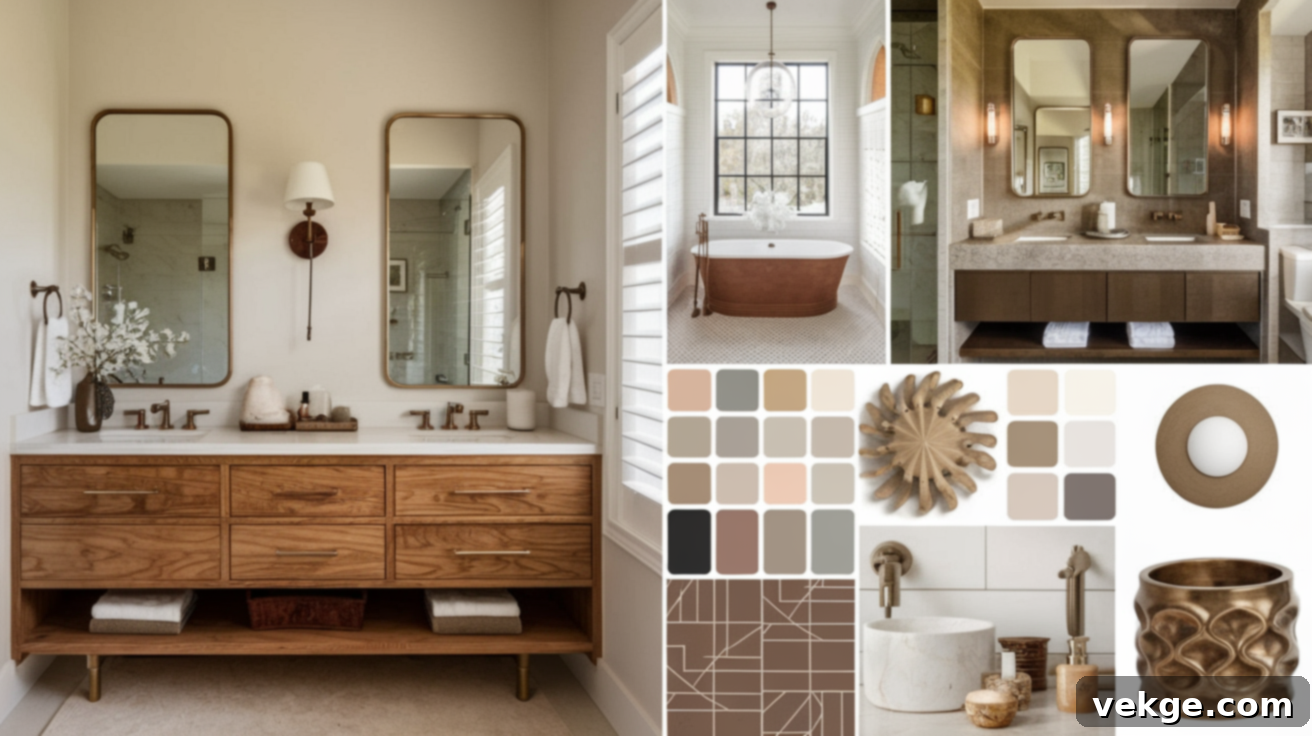
Step-by-Step: How to Design Your Dream Transitional Bathroom
Crafting a truly transitional bathroom is an art form focused on achieving the perfect synergy between classic elegance and modern functionality. This versatile style is celebrated because it manages to feel both cutting-edge and enduringly classic simultaneously. Let’s break down the design process into manageable steps, empowering you to create a bathroom that is not only stunning today but will continue to inspire for many years to come.
Step 1: Define Your Harmonious Color Palette
The chosen color scheme is the bedrock that sets the entire mood and character of your bathroom. Most transitional bathrooms elegantly begin with a serene, neutral base, intelligently layering in accent colors to add depth and personality. Crisp whites, soft grays, warm beiges, and the ever-popular greige serve as superb foundational colors. To maintain a cohesive and tranquil ambiance, aim to limit your primary palette to 3-4 carefully selected colors.
Effective accent colors that enhance a transitional aesthetic include:
- Black: Provides striking contrast and sharp definition, grounding the space.
- Navy Blue: Offers a sophisticated, classic touch that feels both bold and timeless.
- Brass or Gold: Infuses warmth, luxury, and a hint of vintage charm.
- Terracotta or Earth Tones: For a natural, organic, and grounding feel.
- Soft Greens or Blues: Introduce a calm, refreshing, and spa-like quality.
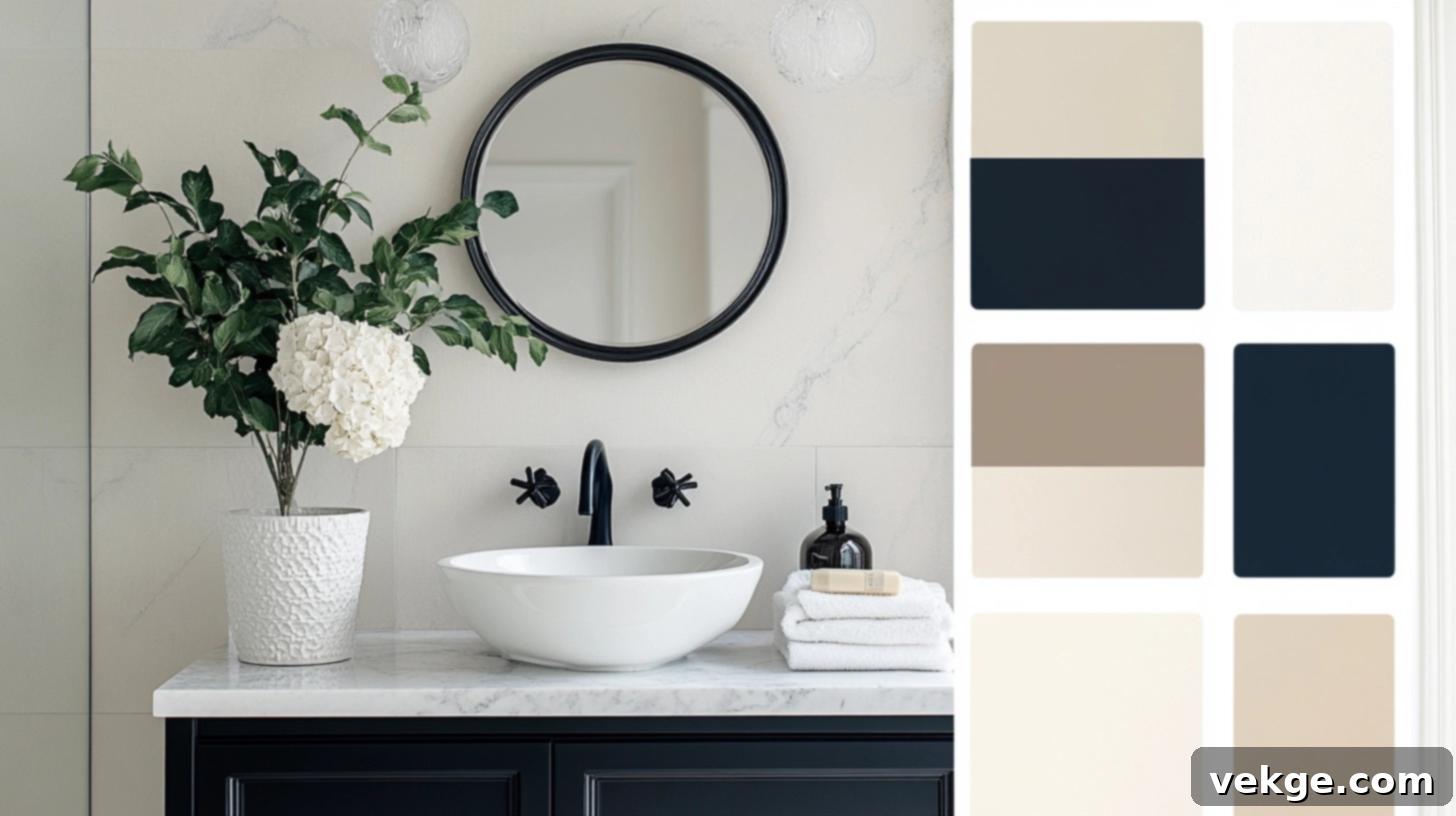
Step 2: Select the Right Fixtures and Finishes
Fixtures are not merely functional components; they are pivotal style statements in your bathroom. For vanities, seek designs that feature simple, clean lines with minimal ornamentation. Shaker-style doors offer a nod to classic craftsmanship, while floating vanities provide a distinctly modern, airy feel. Always prioritize quality materials like solid wood or high-grade painted finishes, ensuring durability and a luxurious look.
- Vanities: Opt for simple lines, shaker-style doors, or modern floating designs. Prioritize quality materials like solid wood or well-finished MDF.
- Mirrors: Choose mirrors with sleek metal or wood frames, or even frameless options. Round or oval shapes can soften the angularity often found in modern elements.
- Sinks: Undermount sinks contribute to a clean, integrated countertop look. Vessel sinks can act as a striking focal point, blending traditional basin forms with modern placement.
- Faucets & Hardware: Ensure a consistent finish (brushed nickel, polished chrome, or matte black are popular choices). Select designs that are simple and elegant, avoiding overly ornate or extremely plain styles. Invest in high-quality hardware for both longevity and a premium feel.
- Toilets: Wall-mounted or skirted toilets offer a streamlined, easy-to-clean modern appearance that blends well with transitional aesthetics.

Step 3: Focus on Thoughtful Tiles and Flooring
The right selection of tiles and flooring is essential for introducing texture, pattern, and visual interest into your transitional bathroom. For wall tiles, classic subway tiles remain a timeless choice, while larger format tiles can provide a more contemporary and expansive feel. Consider subtle marble or stone-look porcelain options for an elevated, sophisticated touch. For flooring, small hexagonal or penny tiles can add a charming, traditional detail, while wood-look porcelain tile brings warmth and resilience. Large format tiles on the floor minimize grout lines, contributing to a clean, uncluttered look.
The color of your grout plays a surprisingly significant role in the overall appearance of your tile:
- Light Grout with Light Tile: Creates a seamless, clean, and airy look.
- Dark Grout with Light Tile: Introduces graphic contrast, emphasizing the tile pattern and adding a touch of modernity.
- Matching Grout: Makes tile lines less noticeable, creating a more uniform and expansive surface.
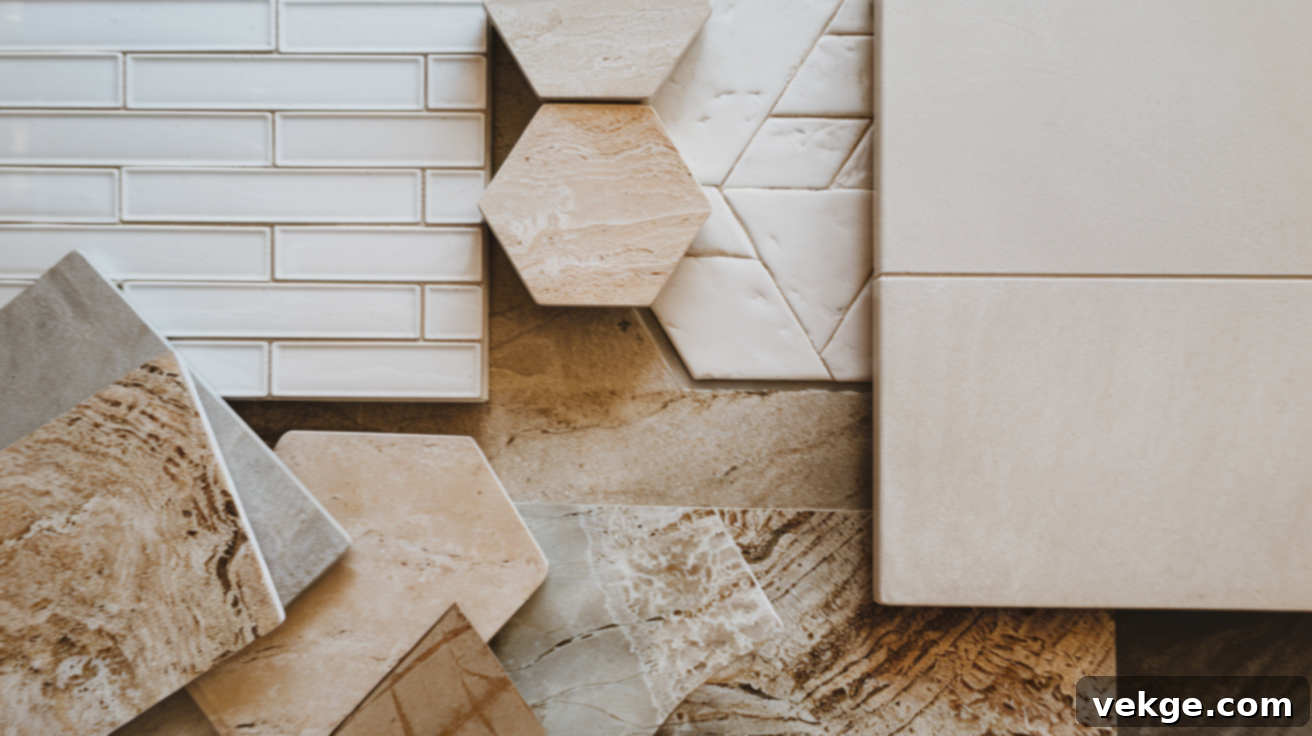
Step 4: Implement Smart Storage Solutions
Effective storage is paramount for maintaining a clean, organized, and truly functional transitional bathroom. Well-designed built-in cabinets offer discreet hiding places for personal items, keeping surfaces free of clutter. Open shelving provides opportunities for display, allowing you to showcase carefully chosen decorative items or neatly folded towels, while also offering easy access to frequently used necessities. A tall linen tower can provide ample space for towels, extra toiletries, and cleaning supplies. Recessed medicine cabinets that blend seamlessly with your wall or mirror add invaluable function without visually dominating the space.
Consider these versatile storage options:
- Integrated Vanity Storage: Vanities with deep drawers, pull-out organizers, and hidden compartments.
- Built-in Cabinetry: Custom or semi-custom units that blend with your wall finishes for a seamless look.
- Floating Shelves: For displaying decorative items or small, folded towels.
- Linen Towers: Tall, narrow units that offer vertical storage without taking up much floor space.
- Recessed Medicine Cabinets: Functional and discreet, often mirrored or designed to match the vanity.
- Woven Baskets and Decorative Bins: Perfect for grouping smaller items and adding texture.
The most effective storage solutions are those that are both aesthetically pleasing and genuinely useful. In smaller bathrooms, prioritize multi-functional pieces, such as a vanity with generous drawer space or a wall-mounted unit that doubles as a display shelf.

Step 5: Add Harmonious Finishing Touches
The final, carefully selected details are what truly bring your transitional bathroom to life, imbuing it with personality and a sense of completion. Thoughtful lighting choices are crucial: consider elegant sconces flanking the mirror for task lighting, a small chandelier for a touch of glamour, recessed lighting for ambient brightness, and under-cabinet lighting for subtle illumination during nighttime use.
Elevate the space with high-quality towels in colors that complement your chosen scheme, simple yet striking artwork in frames that echo your fixture finishes, and vibrant plants for a natural touch of life and color. These elements should feel curated and intentional, rather than merely decorative.
Essential finishing touches to consider:
- Coordinated Lighting Fixtures: Layer lighting for both function and ambiance (sconces, recessed, decorative pendants).
- Premium Towels and Bath Mats: In colors and textures that enhance your palette.
- Thoughtful Artwork and Wall Decor: Simple, framed pieces or abstract prints that align with the transitional aesthetic.
- Greenery: Real or high-quality faux plants to add organic texture and freshness.
- Matching Accessories: Soap dispensers, tissue box covers, and waste bins that tie into your chosen metallic finishes or color scheme.
- Shower Curtain or Glass Door: A high-quality fabric shower curtain with a subtle pattern or a sleek, frameless glass shower enclosure.
- Rugs: A small, tasteful rug can add warmth and define the space.
In the best transitional bathrooms, every accessory feels like it belongs, serving both an aesthetic and a practical purpose. By diligently following these steps, you will craft a transitional bathroom that is not only exquisitely designed and highly functional but also possesses an enduring style that will captivate for many years to come.
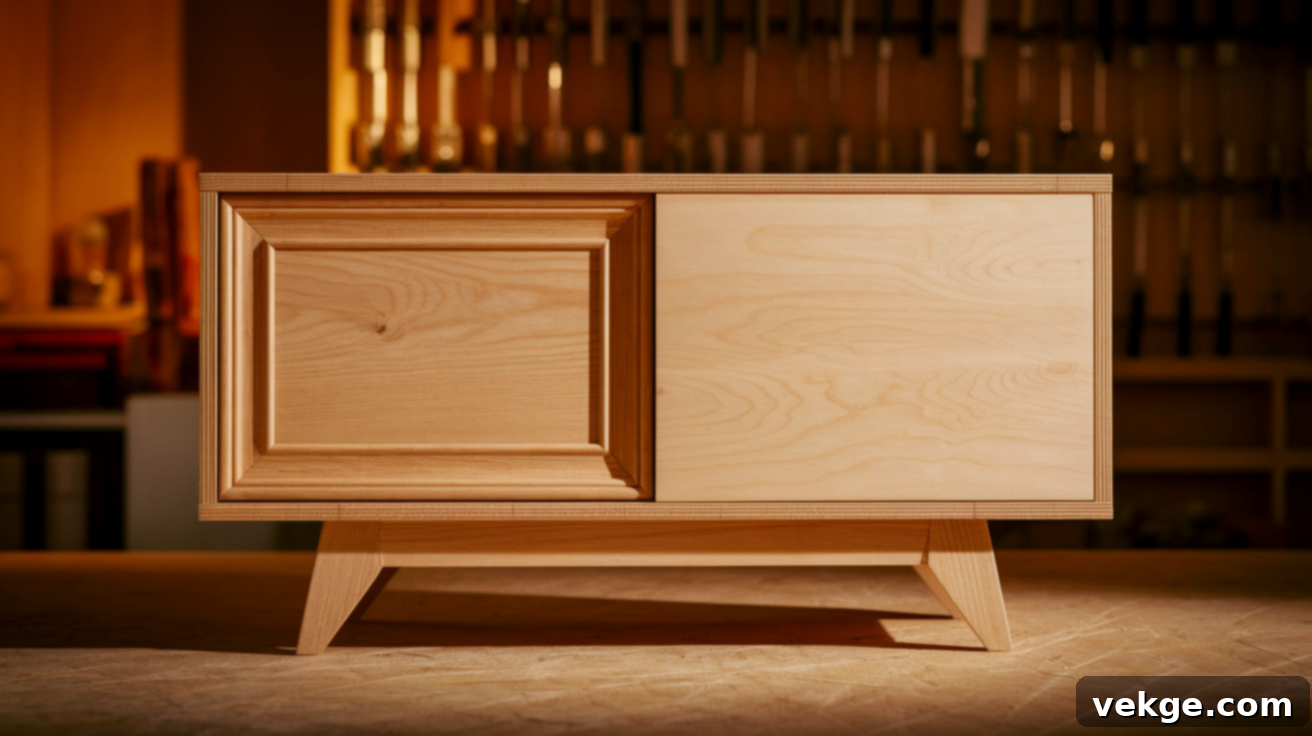
Transitional Design Ideas for Every Bathroom Size
The dimensions of your bathroom significantly influence how you approach a transitional design. What works perfectly in a compact powder room will require different strategies in a sprawling master en-suite. Adapting the transitional style to various footprints ensures both functionality and aesthetic harmony.
Designing Transitional Small Bathrooms
Creating a captivating transitional look in a smaller bathroom or powder room demands clever planning and smart choices. Light and reflective colors, such as crisp whites, soft grays, and pale beiges, are instrumental in making the space feel larger, brighter, and more inviting. Using the same color for both walls and trim can create a seamless, expansive look, blurring the lines of the room.
Space-saving fixtures are paramount. Consider wall-mounted toilets and sinks to free up floor space, corner sinks where appropriate, and combined shower-tub units or sliding glass shower doors to maximize limited square footage. For storage, recessed medicine cabinets offer discreet functionality, while door-mounted towel bars and small, strategically placed floating shelves provide essential organization without clutter. A generously sized mirror above the sink and clear, frameless glass shower doors are visual tricks that can make a small room feel twice its actual size by reflecting light and offering unobstructed views.
Elevating Large Master Bathrooms with Transitional Style
Larger bathrooms provide a luxurious canvas for statement pieces while still maintaining the refined balance of transitional style. Freestanding bathtubs, often considered the epitome of elegance, make perfect focal points; position one artfully under a large window or enhance its presence with a small, exquisite chandelier overhead. Double vanities are not just a functional necessity but also offer a grand aesthetic, providing ample space for two users.
In a spacious master bath, consider zoning the area to define distinct spaces for bathing, grooming, toilet, and even a small dressing area, enhancing both luxury and organization. Large-format tiles for both floors and walls can significantly reduce grout lines, creating a clean, expansive, and high-end look. With more wall space available, you can incorporate more substantial artwork or decorative elements, maintaining a beautiful balance between traditional grandeur and modern simplicity without overwhelming the room.
Maintenance and Care Tips for Lasting Beauty
Diligent care is key to preserving the pristine appearance and functionality of your transitional bathroom for many years. Different surfaces require specific cleaning approaches to ensure their longevity and beauty. For ceramic or porcelain tiles, use mild, pH-neutral cleaners. Natural stone surfaces like marble and granite necessitate specialized stone cleaners to protect their porous nature and prevent etching. Wood vanities should be cleaned with a damp, soft cloth and mild wood-friendly solutions, avoiding abrasive chemicals. Glass and mirrors will remain streak-free with a simple solution of vinegar and water or a good quality glass cleaner.
Effective moisture control is absolutely crucial in any bathroom environment. Always run exhaust fans during and for at least 15-20 minutes after showers to prevent mold and mildew growth. Conduct monthly checks for any leaks under sinks, around faucets, and near other plumbing fixtures. Regularly inspect and maintain the caulk and seals around your tub, shower, and sink to prevent water infiltration and damage. For natural stone and grout, consider applying a sealant annually to protect against water penetration and staining.
The inherent beauty of transitional style lies in its enduring appeal, but small, thoughtful updates can keep your space feeling fresh and invigorated without the need for major renovations. Try these quick refreshers:
- Textile Swap: Introduce new towels, bath mats, and even a shower curtain in different colors or textures to instantly change the mood.
- Hardware Refresh: Update cabinet pulls, drawer knobs, and towel bars to a different finish or style for an immediate impact.
- Lighting Upgrade: Swap out old light fixtures for new, more modern or elegantly traditional designs.
- Art & Accessories: Change out existing artwork or bring in new decorative accessories to reflect current tastes or seasonal themes.
- Seasonal Decor: Incorporate seasonal elements, like vibrant plants in spring, a collection of seashells in summer, or warm, metallic accents and scented candles in fall and winter.
Consistent care coupled with occasional, minor aesthetic changes will ensure your transitional bathroom retains its timeless appeal, safeguarding your investment and providing continuous joy without demanding extensive overhauls.
Conclusion: Your Timeless Transitional Bathroom Awaits
Creating a transitional bathroom truly offers the best of all worlds – the enduring staying power of classic design harmoniously blended with the clean, fresh simplicity of modern style. By expertly mixing traditional elements with updated touches, you achieve a space that is not only perfectly functional and aesthetically pleasing today but will continue to look sophisticated and relevant for decades to come.
The ultimate key to successful transitional design is balance. Carefully choose a selection of traditional pieces, introduce some contemporary elements, and then elegantly tie everything together with a cohesive neutral color palette, thoughtfully chosen materials, and high-quality finishes. The result is a bathroom that feels both established and contemporary, a true sanctuary.
Are you now ready and inspired to embark on your bathroom design project? We are eager to hear your plans and ideas! Please share your thoughts in the comments section below, or feel free to ask any questions you may have about designing your very own timeless transitional bathroom. Your dream bathroom is closer than you think!
